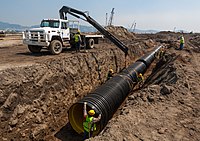
Photo from wikipedia
Agricultural phosphorus (P) loss, which is highly variable in space and time, has been studied using the hot spot/hot moment concept but increasing the rigor of these assessments through a… Click to show full abstract
Agricultural phosphorus (P) loss, which is highly variable in space and time, has been studied using the hot spot/hot moment concept but increasing the rigor of these assessments through a relatively newer "ecosystem control point" framework may help better target management practices that provide a disproportionate water quality benefit. Sixteen relatively large (0.85 ha) subsurface drainage plots in Illinois, USA were used as individual observational units to assess dissolved reactive P (DRP) concentrations and losses within a given field over four years. Three plot-months were identified as DRP control points (one export and two transport control points) where each plot-month contributed > 10% of the annual DRP load from the field. These control points occurred on separate plots, and in both the growing and non-growing seasons, but were likely related to agronomic P applications. Elevated soil test P, especially near a historic farmstead, and soil clay content were spatial drivers of P loss across the field. The non-growing season was hypothesized to be the most significant period of P loss, but this was only documented in two of four years. A cereal rye (Secale cereale) cover crop did not significantly reduce DRP loss in any year, but there was also no evidence of increased drainage P losses due to freezing-thawing of the cover crop biomass. This work confirmed annual subsurface drainage DRP losses were agronomically small (< 3% of P application rate), although the range of DRP concentrations relative to eutrophication criteria still demonstrated potential for negative environmental impact. The control point concept may provide a new lens to view drainage DRP losses, but this framework should be refined through additional within-field studies because mechanisms of P export at this field were more nuanced than just the presence of tile drainage (i.e., a transport control point). This article is protected by copyright. All rights reserved.
Journal Title: Journal of environmental quality
Year Published: 2022
Link to full text (if available)
Share on Social Media: Sign Up to like & get
recommendations!